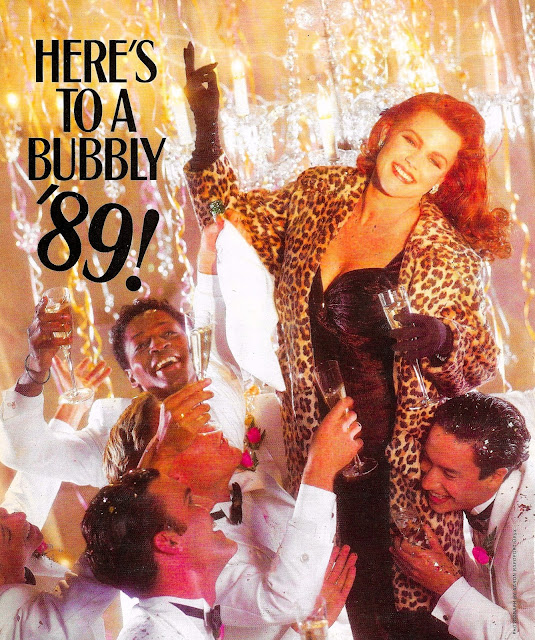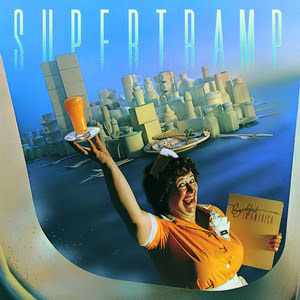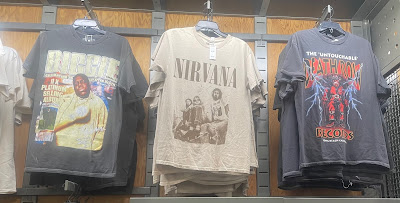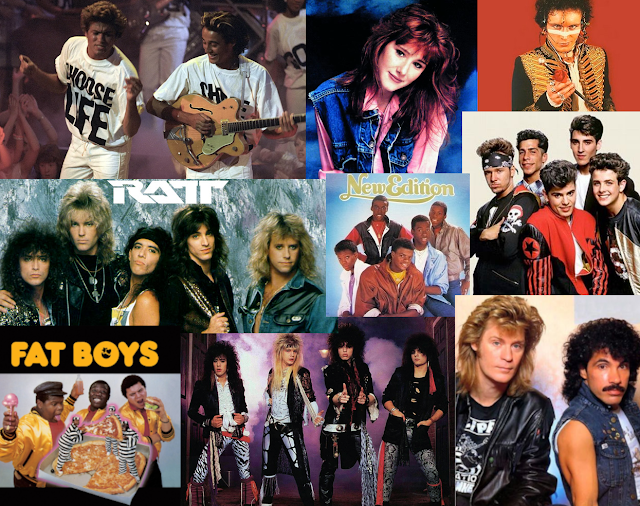December 31, 2023
Happy New Year (from Belinda Carlisle!)
December 27, 2023
Great Album Covers: Breakfast in America, Big Lizard in My Backyard and She's So Unusual
The cover for Supertramp's 1979 smash Breakfast in America is nothing short of a masterpiece of composition. It features the view from an airplane window of a wonderfully inventive interpretation of New York City. In the foreground, a smiling waitress poses like the Statue of Liberty. In her right hand she holds a tray with a glass of orange juice substituting for a torch. In her other hand, instead of a tablet, is a menu featuring the album's title. Behind her is a model cityscape of Manhattan -- an assortment of high rise buildings and skyscrapers represented perfectly by plain but cleverly arranged salt and pepper shakers, condiment bottles, coffee cups, egg cartons and other breakfast-related items. A year following its release, this album deservingly won a Grammy Award for Best Recording Package.
Cover art doesn't get much more on the nose than what you see on this, the Dead Milkmen's first album. But the cartoonish illustration (designed by the band's drummer) is also whimsical and consistent with the band's style of injecting humor into its hardcore punk.
Photographed by the legendary Annie Leibovitz, the cover of Cyndi Lauper's 1983 debut LP She's So Unusual helped establish her zany persona. The shot captures Lauper in the middle of some jerky, uninhibited barefoot dancing in front of a wax museum in Coney Island, a Brooklyn, NY neighborhood close to where Lauper grew up. The photo's kinetic energy and the cover's bright splashy colors convey the playful, care-free spirit of both the artist and American zeitgeist in the early 1980's. Interestingly, decades after the album's release, several additional photos from this cover shoot surfaced (see below.)
November 28, 2023
How Today's Teenagers Are Embracing Nirvana and Other 90's Pop Culture
November 18, 2023
Matthew Perry was Beloved by All -- but his Untimely Death Hits Gen X-ers the Hardest
Matthew Perry's recent, sudden death sparked an outpouring of grief and fond remembrances within the Hollywood community. It also brought a great deal of sadness to fans of the actor and just about anyone who's ever watched and loved him on television. Perry's talent extended far beyond a single TV show (I first noticed him in a guest shot he did on Just the Ten of Us in 1989 and also thoroughly enjoyed him opposite Salma Hayek in 1997's Fools Rush In.) Still, the actor will always be most remembered most as hilarious smart-aleck Chandler Bing on Friends. And therein lies the reason why Perry's death is especially painful for those of us in Generation X. It's because Friends is undeniably a Gen X show.
In Friends first season (1994) we learn that Monica (and her high school classmate Rachel) are twenty-six years old. The rest of the gang is also right around this same age, with Ross (and possibly Phoebe) only slightly older. So when you do the math, Monica was born in 1968, placing her and the rest of the Friends squarely in Generation X. Numerous storylines and references throughout the series back this up. From Ross's fixation on Princess Leia in Return of the Jedi, to Chandler's Flock of Seagulls haircut and admission of rushing the stage at a Wham concert, clearly these characters grew up in the 80's and thus are unquestionably part of Generation X. That clarified, it's no wonder that Perry's death hits us the hardest. We've lost one of our own.
My high school class recently had a well-attended reunion and though I wasn't able to make it, I took time to pour over the gallery of photos that were posted online in the days after. While clicking through, I smiled and laughed seeing faces from my past for the first time in literally decades. The funny thing was I wasn't even friends with most of these people. I made all of my lifelong friendships during college and to this day remain in touch with only a single high school pal. Nevertheless it warmed my heart to see people I spent four of my most formative years with and know, despite the abundance of receding hairlines and expanding waistlines, they were alive and doing well. Somehow, we all tend to have very strong sentiments towards our peers and those with whom we've shared a common, significant experience. But the flipside of that feel-good sentiment is the gut-punch and sense of loss we suffer when we learn that one of our comrades is now gone.
That's what many of us are feeling with Matthew Perry's death. Friends was the ongoing story of six Gen X-ers trying to make it in the world as they laughed with, leaned on and loved each other. As we did with the abundance of teen movies in the 1980's (e.g., The Breakfast Club, Fast Times, Risky Business) Gen X-ers saw authentic versions of themselves and their lives in the Friends characters -- whether it was Ross (smart and sensitive and carrying unrequited love) or Phoebe (so unapologetically authentic in her flakiness) or Chandler, with his rapier wit and brandishing sarcasm hiding underlying insecurities.
Many will say that Friends is a show that belongs to far more that just a single generation and that it appeals to Millennials and Zoomers as much as any other age group. This is certainly true. Enough time has gone by now that we can safely say that Friends, and many of it's themes, storylines and characters are classic. Nevertheless, the show provided a different experience for us Gen X-ers who tuned in during its original run. We were watching ourselves -- young adults in their mid-20's, living post-college life in the 90's, going through the same things we were at that same moment in time. For example, when Friends debuted, many Gen-X women (my girlfriend included) had just moved out of their parents' house, started their first real job and were realizing independence for the very first time -- just like Rachel in the pilot episode. Like Joey, many of us were pursuing a career in acting or the arts and working odd jobs to pay rent while we pursued our dream. And while young people watching the show for the first time even today can definitely relate to universal themes like this, at the time it originally aired Friends meant the most to Gen-Xers who got to come home, click on the TV and see Ross, Rachel, Monica, Phoebe, Joey and Chandler living their same lives -- or perhaps the lives we wished we had. These were our peers... our contemporaries... our cohorts. And losing one of those is often the hardest blow to take...
R.I.P. Matthew.
October 26, 2023
Board Games of the 1970's Highlighted Americans' Angst
So could it be that all of the fear, pressure and angst built up during the 1970's manifested itself in, of all things, the decade’s most popular board games? Consider some of the ones that were best selling and most played at the time and the gameplay each involved:
October 16, 2023
And the Most Beloved (but Embarrassing) Artist of the 80's is... Adam Ant!
Started an open-ended discussion on Reddit recently asking which 80's band or artist do/did you love BUT are kind of ashamed to admit. The many responses ranged from the obvious (Tiffany, Kenny G, New Kids on the Block) to the obscure (Sigue Sigue Sputnik.) The conversation sparked remembrances of long forgotten acts like Cameo, Winger and El Debarge, shout outs to the criminally underrated ABC and Human League, and confessions by unabashed metal heads of their secret love for Madonna and Debbie Gibson. But surprisingly, the number one artist (measured by mentions in comments and subsequent upvotes) was British new waver Adam Ant...
Cyndi Lauper, Huey Lewis and the News, Genesis, Pet Shop Boys and Warrant all fared well but the top five are listed below.
Adam Ant - 101
Air Supply - 67
Wham/George Michael - 57
Ratt - 57
Go-Go's - 33
The Cure - 26
Related Posts:
10 Songs That Defined The 80's
October 4, 2023
Family Guy's Funniest Pop Culture References, Vol. 2
Peter gets a little lost was traveling on the Great Space Coaster.
Now we know what happened to the other three Friends cast members.
It's true -- you never realized how disturbing the Lost in Space plots actually were.
Popeye is having health problems.
Peter falls in love with Kathy Ireland (sort of) and croons a Billy Ocean tune.
September 25, 2023
The Pop Culture Fiend Photo Gallery is Finally Here!
The Pop Culture Fiend Archives includes an extensive collection of popular (and obscure) periodicals dating back as far as the early 1980's. My closets house crates and bins with literally hundreds of magazines (from a wide variety of genres) including Time, Newsweek, People, Us, Ebony, Sports Illustrated, Flex, Ironman, Muscle and Fitness, Runners World, Tennis, Men's Health, GQ, Vanity Fare, Cosmopolitan, Elle, Vogue, Glamour, Mademoiselle, Photo and Rolling Stone. The collection also includes defunct titles like Maxim, Stuff, Spin, Spy, Entertainment Weekly, InStyle, Life, U.S. News & World Report, Sport, Parade, Premiere, Movieline and Playboy; along with several short-lived and/or long forgotten ones like Details, Detour, Model, Mouth to Mouth, Code, Bikini, Razor, Inside Sports, and Mirabella.
Now in addition to these full issues that take up far too much of my closet space, there were also scores of other issues that I chose to get rid of... but not before I clipped and saved a ton of their best and coolest articles and photos. These photos now occupy yet another plastic storage container in my humble dwelling and now, after many, MANY years, I've finally gotten around to scanning/digitizing them so they can be preserved and shared. You can scroll to see some of my first batch and I'll also be posting a lot of these to relevant communities on Reddit, including subs like r/OldSchoolCelebs, r/80s, r/90s, r/ClassicScreenBeauties and r/GenX.
Finally, know that many of these photos are extremely rare. I Google image searched a bunch of them and in many instances didn't find them anywhere else on the internet. So I guess props to me for being the conscientious custodian and curator of this content. After all, there aren't many of us who possess such a volume of 30-40 year old magazines and photos, or who would take the time to scan, digitally enhance, upload and publish them online.
I guess that's just what makes me the Pop Culture Fiend.
 |
| Richard Gere in costume for The Cotton Club - 1984 |
.jpg) |
| Belinda Carlisle - 1988 |
.jpg) |
| Farrah Fawcett - 1990's |
.jpg) |
| Bruce Willis |
 |
| Cybill Shepherd |
.jpg) |
| Salma Hayek |
.jpg) |
| Patti Smyth (former lead singer of Scandal) - 1988 |
 |
| 80's stars Demi Moore, Emilio Estevez, Melissa Gilbert & Rob Lowe at an anti-nuke event |
.jpg) |
| Billy Joel & Christie Brinkley |
.jpg) |
| Natasha Henstridge |
July 24, 2023
40 Years Ago, Risky Business Legitimized Teen Comedy
With due respect to the John Hughes' classic The Breakfast Club, the most important teen movie of the 1980's may very well be Risky Business. Released 40 years ago, Paul Brickman's Risky Business legitimized teen comedy like no film before it and set the stage for the “High Renaissance” of that subgenre that took place in the middle of the decade.
The early 1980's was an era filled with “high school boys looking to get laid” comedies (e.g., Porky's, Losin' it, My Tutor) that were thin on story and heavy on goofy, sometimes inane, humor. But then Risky Business comes along, featuring that same teenage boy out for sex... except now we get to see WHY he's experiencing that sexual frustration (as well as a ton of other anxiety.) We witness the pressure he feels (some applied by his parents, some self-imposed) to raise his SAT score, join school clubs he has little interest in, and get accepted into the college not he, but his parents want. Tom Cruise's Joel Goodson was the first Gen X hero – bored, disillusioned, forced down paths he's not sure he wants to tread and enduring a suburban hell complete with a pristine home/prison, successful parents he can never please or measure up to, and a voice in his head warning he'll “never have a future.” As Joel courageously tries to live up to his surname, his attempts to relieve his growing angst by defiantly maxing the volume on the family stereo and joyriding in his dad's Porsche prove insufficient. Though the apprehension he feels about where he's headed in life is apparent, relief seems unattainable. That is until he's pointed to call girl named Lana with the promise, “It's what you want... it's what every white boy off the lake wants.” It's this exploration of the unknown – the dark, not so pristine world of sex, prostitutes, and life or death run-ins with “killer pimps” – that drives the story of this restless, uneasy Gen-X teenager.
It wouldn't be until the middle of the decade – with Hughes' Breakfast Club, Pretty in Pink, Some Kind of Wonderful trilogy – that teen comedies would so earnestly acknowledge and portray the contemporary fears and anxieties of those of us who came of age in the 80's. Joel's experience in Risky Business underscored a generation's gnawing need to subvert societal conventions and oblivious parents who failed to recognize how much emotional turmoil we were in as we struggled to figure out who we were and what should come next. In the process, we also had to navigate our way through expectations of continuing the American familial tradition that existed since the Great Depression, whereby each succeeding generation acquired more wealth and success than their parents. In these ways, Risky Business actually defined Gen X, crystallized its world view and authored its motto with the ironic and oft quoted line, “Sometimes you gotta say, 'what the fuck.'”
Risky Business would proceed to enter the zeitgeist in several ways. The scene where Joel slides across the hardwood floor in his socks became instantly iconic and has been parodied in everything from The Simpsons to video game commercials. Cruise's wardrobe in the film -- Docksiders, button down dress shirts, Izod polos – became the standard for preppies everywhere and after he sported 60's style Ray Bans in multiple scenes, the brand saw a resurgence that continues to this day. Risky Business proved particularly popular among college students, so much so that within six months, it was screening on university campuses and the film's one-sheet was pretty much the coolest thing you could have hanging in your dorm room. By the following fall, the film was a mainstay on HBO and its many memorable lines -- including “Get off the babysitter!”, “Porsche, there is no substitute.” and “Looks like University of Illinois!” -- were being quoted ad nauseum.
Risky Business further set itself apart with its artful cinematography (Lana’s first appearance; the train sequence) and an ethereal original score by Tangerine Dream that proved a huge departure from the typical teen movie soundtrack full of contemporary pop and new wave hits.
The end result saw audiences immediately embracing the film and its stars. Risky Business grossed $63 million on a $6 million budget and, boosted by positive word of mouth and a strong second run, would finish as the eighth highest grossing film of the year and the #2 comedy behind only Trading Places. An unknown Rebecca De Mornay (who won the role of Lana after Michelle Pfeiffer passed) was catapulted to Hollywood's A-list and, though she worked sparingly, graduated to starring roles in The Trip to Bountiful, The Slugger's Wife, and the And God Created Woman remake. Over her career, she's delivered a string of stellar but overlooked performances in films like Runaway Train, The Three Musketeers and The Hand That Rocks the Cradle. Oh, and that Cruise guy did okay too – starring in films that grossed a combined $10 billion at the box office, earning multiple Oscar nominations and becoming what many consider to be “the last Hollywood movie star.”
Now, forty years later we can look back at Risky Business and it's cleverly written script as the teen comedy that broke the mold and forged an alternative paradigm for the sub-genre. With its more serious take on the teen experience – in this case, through its The Graduate-like themes of eschewing the supposed American dream of an Ivy League education, landing a high paying job, and moving to the suburbs – Risky Business paved the way for John Hughes' films, Say Anything, Adventureland, and virtually every other smart, thoughtful teen comedy that followed.
Related Posts:
The Evolution of the 80s Teen Movie - How Bob Clark, Gen X, and Home Video Changed the Landscape of American Cinema
The Evolution of the 80s Teen Movie - How Bob Clark, Gen X, and Home Video Changed the Landscape of American Cinema - Part II
Welcome to Pop Culture Fiend
July 17, 2023
Explaining to an Alien How Humans Brush Their Teeth
July 8, 2023
A Deep Dive into Barry Allen's Speed: Exactly How Fast is The Flash?
So with Barry as the focus, when you examine his history and look for references in the comics about his speed, you discover a lot of inconsistency. Early Silver Age issues make a big deal about Barry running on water (something by the way, that would be scientifically possible for a human running even as "slow" as 50 mph) as well as overcoming gravity by running up the sides of buildings. On the higher end of the scale, we see Silver Age Flash breaking the sound barrier. Comic book writers magnifying each of these specific exploits made a lot of sense at the time. In the 50's and 60's, rocket technology, jet engines, Chuck Yeager going Mach 1, etc., represented the outer reaches of what humans could achieve -- so an “ordinary man" gaining powers to match these types of things was superhuman enough for the comics. (It's very similar to the way Superman, around the same time, was heralded for being "more powerful than a locomotive.") But as we moved into the 1970's and travel faster than sound became so routine that even commercial airlines offered it, the limits of Flash's speed predictably creeped up and his exploits (as we'll see) became more fantastical.
For DC, the Bronze Age ended with 1985's Crisis on Infinite Earths in which DC's "multiverse" was eliminated in favor of a single Earth and the entire DC universe was neatly consolidated. The fallout from this was particularly impactful for the Flash because in Crisis on Infinite Earths #8 Barry Allen dies as a result of running so fast and with such intensity that he literally disintegrates. At the same time, to maintain consistency, The Flash comic was canceled. When it was brought back shorty after, Wally West became the new Flash until Barry's return in 2009's Flash: Rebirth. When Barry returns, he is notably faster than he was during his original run through DC's Silver and Bronze Age comics. This is significant because the explanation provided in Rebirth for Barry's absence for more than 20 years is that he wasn't actually dead but rather that he became one with (and/or was trapped in) the Speed Force.
So now we have to take another step back...
The Speed Force is an energized plane of existence from which DC's "speedsters" draw power. Modern issues of The Flash, the WB series, the new movie, and every other modern take on the Flash include the Speed Force as part of the character's lore. It was introduced, in part, to address and/or resolve questions regarding the anatomical damage a human body would most certainly suffer by running at such incomprehensible speeds. The Speed Force puts a powerful aura around whoever is tapping into it, thereby protecting them from speed-related friction, G-forces, etc. In other words, the Speed Force explains why Flash's costume (and skin) don't tear off... how he's able to see and hear while he runs... and why he doesn't constantly cause sonic booms.
But the Speed Force is much more than just a protective barrier. It’s also a cosmic realm speedsters can use to travel anywhere in space and time. Those deft or experienced with the Speed Force can enter it and exit anywhere they like. Those not so skilled can get trapped and lost in the Speed Force indefinitely.
But here's the thing... The Speed Force was never a part of the Flash's original lore... Not even close. The first reference to it occurs in 1994 in The Flash #91 written by Mark Waid. He and other Flash writers, including Grant Morrison and Geoff Johns, through their stories, established the Speed Force as an integral part of the Flash's mythology moving forward and also retroactively applied it to Barry Allen's history, along with Jay Garrick's, and well, all other speedsters (good and evil) who ever existed in the DC universe.
This means that Barry's speed and all of his speed-related past deeds, including time travel, are now explained as being made possible by the existence of the Speed Force. Johns, in Flash: Rebirth even took things a step further by explaining that Barry actually created the Speed Force himself when the lightning bolt struck him in his lab. Once that happened, the Speed Force began expanding in time and space to empower all speedsters before and after Barry. (This origin, however, has been contradicted multiple times and it's now generally accepted that the Speed Force has always existed.) Still, as confusing as its origin may be, the main thing to know about the Speed Force is that it essentially removed all limits to how fast the Flash can travel, up to and including light speed and even beyond.
Upon Barry's "rebirth" he too demonstrates enhanced speed and performs feats infinitely more impressive than he ever had previously, including running in the sky. It seems the "new" Barry is more dialed into and able to draw more power from the Speed Force than most other speedsters apart from Wally West. This results in a vast increase in Barry's top speed during the Modern Age. And it's precisely because the existence of the Speed Force has been retconned into Barry's history, there are presumably no limits to how fast he potentially could have been during the Silver and Bronze Ages either. Looking at it this way neatly reconciles and gives more credibility to the 90,000,000 mph attestation by the DC editorial staff I identified earlier.
In the end, we know this is the world of comics, which is rife with inconsistencies, contradictions and countermanding in matters relating to both character bios and storylines. Arguably, it's Wally who has proved most adept at marshalling the Speed Force and usurping its power to reach new limits but Barry too has used the Speed Force to reach incomprehensible speeds. Depending on how much he's able to tap into it, he has unlimited speed -- faster than light, faster than thought, faster than death, faster than time... He's even fast enough to live an all-encompassing, entirely instantaneous existence...
So yeah, he's pretty freaking fast.

.jpg)














.jpg)









